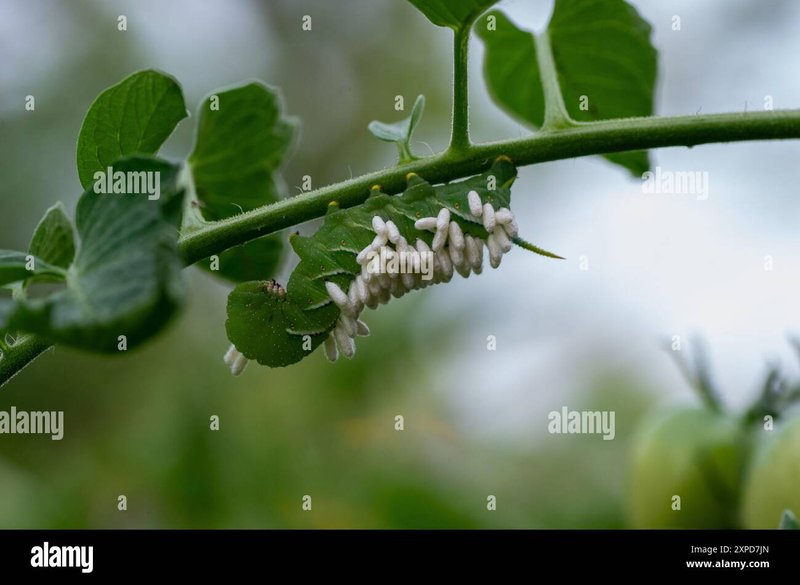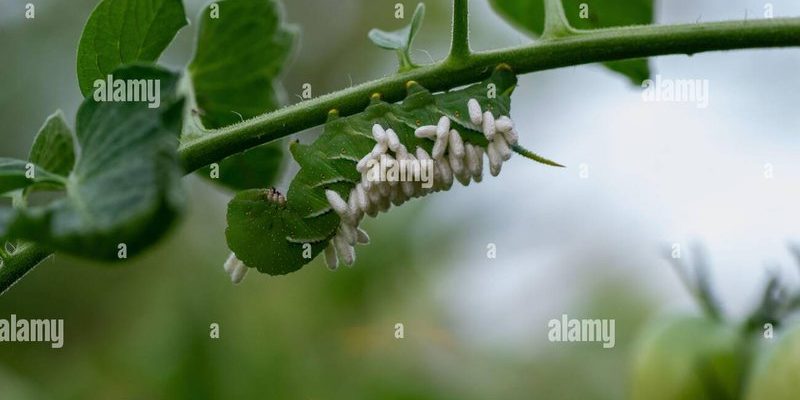
Imagine you’re enjoying a nice day outside, and you spot a hornworm on a tomato plant. You’re just about to take a closer look when you notice something off. Maybe there’s a strange, fuzzy mass on its back, or it seems lethargic. These are signs that the hornworm is not just munching away; it may be a host to parasites. Knowing the signs of parasitism in hornworm larvae can help you manage your garden better and understand the complex relationships in nature. So, let’s dive in!
What Are Hornworms?
Hornworms are the larvae of a few different moth species, primarily the five-spotted hawk moth and the tomato hornworm moth. They grow quite large and can be bright green, often blending in with the leaves of your plants. This camouflage helps protect them from predators, but it doesn’t make them invincible.
These caterpillars are notorious for their appetite. A single hornworm can devour a staggering amount of foliage in just a few days. However, their role in the garden ecosystem goes beyond being simple pests. They’re also a food source for many birds and beneficial insects, showcasing the circle of life.
It’s fascinating how nature works, right? But as you keep an eye on your hornworms, be aware of the subtle signs that might indicate something else is going on underneath their tough exterior.
Common Parasites Affecting Hornworms
Hornworm larvae can fall prey to several parasites, including **braconid wasps** and **tachinid flies**. These tiny creatures have a unique way of reproducing that directly impacts the hornworm’s life.
– **Braconid Wasps**: These wasps lay eggs inside the hornworm. Once the eggs hatch, the larvae feed on the hornworm from the inside out, eventually killing it. It’s like that classic “Alien” movie scenario where something grows inside you. The wasp larvae can often be seen emerging from the hornworm’s body, leaving behind little white cocoons.
– **Tachinid Flies**: Similar to braconid wasps, tachinid flies also use hornworms as hosts for their larvae. However, these flies lay their eggs on the outside of the hornworm. Once the eggs hatch, the larvae burrow into the hornworm.
You might be wondering why this matters. Understanding these parasites isn’t just about keeping your plants healthy; it’s about grasping the balance of nature and how these interactions affect your garden.
Identifying Signs of Parasitism in Hornworms
Recognizing the signs of parasitism in hornworms is key for gardeners who want to take action. Here are some tell-tale signs to look for:
- Abnormal Behavior: If a hornworm seems unusually sluggish or isn’t eating as much as others, this could signal that it’s hosting parasites.
- Visible Cocoons: One of the most concerning indicators is the presence of small white or tan cocoons on the hornworm’s body. This means braconid wasps are at work.
- Changes in Appearance: A healthy hornworm is usually a uniform green. If you spot discoloration or areas where its skin looks damaged, parasites may be the culprit.
- Excessive Movement: If the hornworm is twitching or moving erratically, this can indicate distress caused by parasites.
Keep an eye out for these signs, especially if you’re noticing a decline in your plants’ health. It’s like detective work—you’re piecing together clues to get to the truth!
Impact on Your Garden
The impact of parasitism on hornworms goes beyond just the individual caterpillar. When hornworms fall victim to parasites, it can alter the entire ecosystem of your garden.
First off, parasitized hornworms often die off before they can reach the pupal stage to become moths. This means fewer adult moths and, consequently, less hornworm activity in your garden. While that sounds good, remember that these moths also serve as prey for birds and other garden wildlife.
Interestingly, having parasitized hornworms can also help reduce the need for chemical pesticides. If nature takes care of it by controlling the pest population for you, that’s a win-win! This natural balance can mean healthier plants and a more robust ecosystem.
What to Do If You Find Parasitized Hornworms
If you spot signs of parasitism in your hornworms, you might be at a crossroads: do you remove them, or let nature take its course? Here are a few options:
– **Leave Them Be**: If the infestation is not severe, consider letting the hornworms stay. They can become a food source for beneficial insects or birds. Plus, this adds to the natural cycle of your garden.
– **Remove and Destroy**: If you find a hornworm with lots of cocoons or severe behavior changes, you might want to remove it. This can help prevent the spread of parasitism to others. Just be sure to dispose of it far from your garden to avoid attracting more pests.
– **Monitor the Situation**: Keep an eye on the other hornworms and plants. If you notice more signs of parasitism, it might be time to evaluate the overall health of your garden and make some changes.
Making decisions in the garden can feel like a balancing act between intervention and letting nature do its thing. It’s all about finding what works best for you!
Prevention: Keeping Your Hornworms Healthy
Preventing parasitism in hornworms isn’t always possible. However, there are steps you can take to minimize the chances. Here are some tips:
– **Encourage Beneficial Insects**: Create an environment that attracts natural predators of hornworms, like birds and beneficial insects. Planting flowers and providing shelter can help turn your garden into a wildlife haven.
– **Plant Diversity**: Avoid monocultures by planting a variety of plants. This not only attracts beneficial insects but also confuses pests and reduces the risk of infestation.
– **Regular Monitoring**: Check your plants and hornworms regularly for signs of distress. The earlier you catch potential issues, the better chance you have at managing them effectively.
The key here is to create a balanced ecosystem in your garden that naturally limits hornworm populations and the parasites that might affect them.
Recognizing the signs of parasitism in hornworm larvae can be a game changer for any gardener. By understanding these signs, you’ll better manage your garden and appreciate the intricate relationships that exist in nature. Whether you observe creepy cocoons or just a lethargic caterpillar, knowing what to look for empowers you to maintain a healthy and vibrant garden.
So, next time you’re out there inspecting your plants, keep your eyes peeled and remember: the health of your garden is just as much about understanding the pests as it is about the plants. Nature has a way of working things out, but knowing what’s happening beneath the surface can give you the upper hand in keeping your green space thriving!

